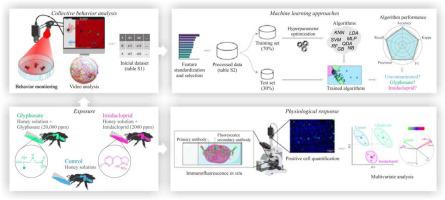Journal of Hazardous Materials ( IF 12.2 ) Pub Date : 2021-09-27 , DOI: 10.1016/j.jhazmat.2021.127344 Rodrigo Cupertino Bernardes 1 , Lorena Lisbetd Botina 1 , Fernanda Pereira da Silva 2 , Kenner Morais Fernandes 3 , Maria Augusta Pereira Lima 4 , Gustavo Ferreira Martins 3

|
Machine learning (ML) is a branch of artificial intelligence (AI) that enables the analysis of complex multivariate data. ML has significant potential in risk assessments of non-target insects for modeling the multiple factors affecting insect health, including the adverse effects of agrochemicals. Here, the potential of ML for risk assessments of glyphosate (herbicide; formulation) and imidacloprid (insecticide, neonicotinoid; formulation) on the stingless bee Melipona quadrifasciata was explored. The collective behavior of forager bees was analyzed after in vitro exposure to agrochemicals. ML algorithms were applied to identify the agrochemicals that the bees have been exposed to based on multivariate behavioral features. Changes in the in situ detection of different proteins in the midgut were also studied. Imidacloprid exposure leads to the greatest changes in behavior. The ML algorithms achieved a higher accuracy (up to 91%) in identifying agrochemical contamination. The two agrochemicals altered the detection of cells positive for different proteins, which can be detrimental to midgut physiology. This study provides a holistic assessment of the sublethal effects of glyphosate and imidacloprid on a key pollinator. The procedures used here can be applied in future studies to monitor and predict multiple environmental factors affecting insect health in the field.
中文翻译:

使用机器学习工具对蜜蜂中的农用化学品进行毒理学评估
机器学习 (ML) 是人工智能 (AI) 的一个分支,可以分析复杂的多变量数据。ML 在非目标昆虫的风险评估方面具有巨大潜力,可用于模拟影响昆虫健康的多种因素,包括农用化学品的不利影响。在这里,探索了 ML 对无刺蜜蜂(Melipona quadrifasciata )的草甘膦(除草剂;制剂)和吡虫啉(杀虫剂,新烟碱;制剂)风险评估的潜力。在体外暴露于农用化学品后,分析了觅食蜜蜂的集体行为。基于多变量行为特征,应用机器学习算法来识别蜜蜂接触过的农用化学品。原地变化还研究了中肠中不同蛋白质的检测。吡虫啉暴露导致行为的最大变化。 ML 算法在识别农用化学品污染方面实现了更高的准确度(高达 91%)。这两种农用化学品改变了对不同蛋白质阳性细胞的检测,这可能对中肠生理学有害。本研究对草甘膦和吡虫啉对一种关键传粉媒介的亚致死效应进行了整体评估。此处使用的程序可用于未来的研究,以监测和预测影响该领域昆虫健康的多种环境因素。











































 京公网安备 11010802027423号
京公网安备 11010802027423号